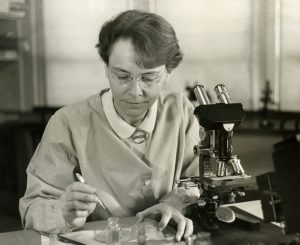By Julija Hmeljak
Summer is my favorite season. I always feel that great things happen when it’s warm and light outside, unlike in gloomy February. Why am I talking about this? Because it was in the glorious summer of 2015 that Sir Tim Hunt, Nobel Laureate, made a clumsy “joke” at a conference dinner that caused an uproar amongst the scientific community and effectively truncated his career. He made a distasteful comment about female scientists not being emotionally stable, apparently in jest, and young female scientists lost their marbles. Later on, he was largely forgiven, since he “clearly didn’t mean it” and “it was a joke”. Apparently, many of the largely female audience bought the joke. It was made at a scientific journalism conference, not at a real scientific conference, so the pundits felt the need to stress that—obviously—women are better at talking science, rather than doing science, and the joke was thus benign.

I do not buy his joke, though. Mainly because my sense of humor is not wired towards blatant gender bias and misogyny, especially in academia. I’m not saying all men are programmed to partake in “locker room talk” behavior. That would be an unfair generalization, and it is not my belief. What, exactly, does this have to do with science? Surprisingly, a whole lot…
Women make up roughly 50% of the general population. Thank you, Captain Obvious. However, a casual perusal shows that more women than men enroll in higher education, perform better and achieve graduation in the US, according to the National Center for Education Statistics. But somehow, in the transition from graduate student through postdoc and onwards to independence and finally to tenure, more women than men disappear off the map. And then there’s the good old gender pay gap.
These differences are difficult to explain in so few sentences, but they absolutely cannot be attributed to mere chance. They likely stem from longstanding systemic bias, which is far too complex and, frankly, too depressing, to be analyzed here. Moreover, some people (particularly some male people) are quick to dismiss them as gross generalizations perpetuated by disgruntled females that failed in the sink-or-swim world of high-profile science.
There is no logical reason why women shouldn’t be just as well-represented as men in any professional area, science included. The problem arises when a scientific career is on the line. In certain disciplines, top male faculty employ more male than female trainees. Female first authors are judged more harshly than men during peer review, hence their work is less likely to be accepted for publication. In the publish-or-perish shark tank, brilliant female scientists lose to brilliant male scientists for no identifiable reason aside from gender bias. If a female postdoc even manages to break into a high-profile (male) mentor’s laboratory, she is less likely to receive a glowing reference letter.
On a day-to-day basis, female scientists are also more likely to be judged based on parameters that have absolutely nothing to do with their skill, intelligence or “stamina”, whatever that means. Apparently, my lipstick habits or the fact that I choose to groom my eyebrows preclude my job-performing capabilities. Sadly, those deeply prejudiced notions didn’t die in the 20th century, when Rosalind Franklin, Barbara McClintock and many others had to fight very hard for fair acknowledgement of their scientific merit.
Roughly a year ago, Eric Lander, president of the Broad Institute, published a perspective with the title The Heroes of CRISPR. Neither he nor the Cell editorial team fact-checked the accuracy of his assessment of Emmanuelle Charpentier’s and Jennifer Doudna’s contributions. His writing was likely fueled by the undisclosed conflict of interest, since the Broad is an interested party in the infamous CRISPR patent dispute. However, it is hard to ignore the the fact that Emmanuelle Charpentier and Jennifer Doudna are women.
I started this piece by talking about the culture of misogyny, even tying it into the current political discourse. However, the aim of this piece is not to preach. I do believe that progress can only be made once an issue is identified, so it can be acted upon. If you have made it this far, you’ve completed the first step in building your awareness that gender bias in the sciences is alive and well. The issue is obviously not new; many have discussed the subject extensively. Listed below are a sampling of additional readings to further expand your awareness.
There is much more one can do beyond reading:
- speak up
- support organizations that speak up about gender equality in science - Discov/Her has a great article listing these organizations;
- take the 500 Women Scientist Pledge;
- attend seminars and lectures given by female scientists and engage in the post-seminar Q&A;
- go see the movie Hidden Figures.
Now you know that gender, and other bias, is alive and well in the hallowed world of science, and every single one of us can do something to fight it.
Suggested reading:
- Astronomer Meg Urry reflects on a turbulent year for women in science.
- Laura Bates of The Guardian understands why there are so few female scientists...
- … Ted Boscia disagrees.
- Jenny Pickerill reflects on how to overcome sexism and stereotypes in higher education
- Emma Sayer discusses bias in peer review
- Danica Savonick and Cathy N. Davidson compile an annotated bibliography of recent studies on the subject
- Katherine L. Milkman, Modupe Akinola and Dolly Chugh accept the challenge (What Happens Before? A Field Experiment Exploring How Pay and Representation Differentially Shape Bias on the Pathway into Organizations)
- Everything at Scitable’s Women in Science forum
- Everything at Tenure, She Wrote
Julija Hmeljak is a postdoctoral fellow at Memorial Sloan Kettering Cancer Center in New York City.
Editors: Tristan Fehr
